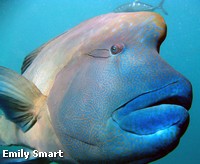
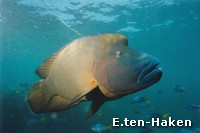
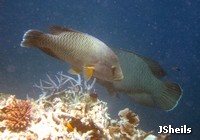
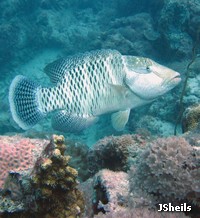
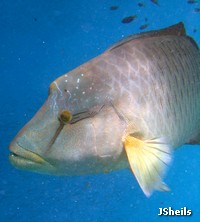
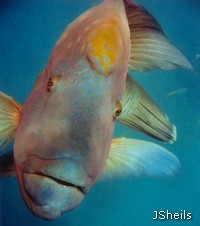
.jpg)
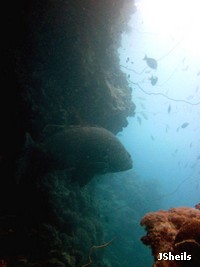
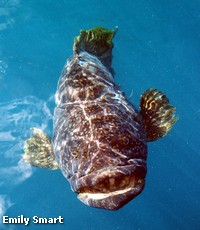
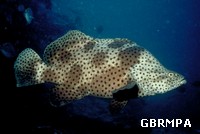
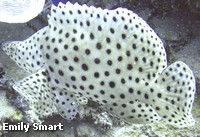
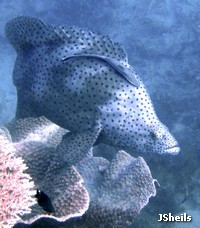
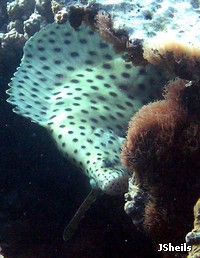
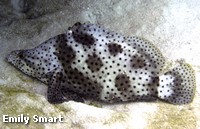
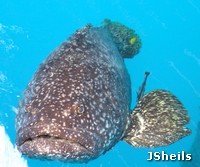
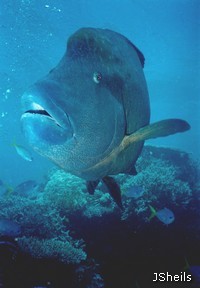
Protected fish species
Humpheaded Maori Wrasse (Cheilinus undulatus)
The biggest Wrasse
The largest of all of the wrasse family of fish (Labridae), these fish reach around 2.3m in length and about 190kg weight, and can live for up to 32 years. They live throughout the tropical Indo-Pacific region, from the Red Sea to the Central Pacific, on coral reefs down to 100m depth. 'Undulatus' in the scientific name means wavy in Latin and refers to the patterns that they have on their face and body.
A seafood diet
Maori Wrasse depend on coral reefs for habitat, where they spend the day searching for the crustaceans, molluscs, echinoderms and small fish that they feed on. They can even eat toxic prey such as sea hares, boxfish and the notorius coral predator, the Crown of Thorns Starfish.
Maori wrasse are skilled at spotting prey hidden in coral crevices, and use the suction of their rapidly opening mouth to suck them out. They are able to use each eye independantly, watching their surroundings for danger as they inspect the reef for food. Divers who have been lucky enough to spend time with them will know that this makes them impossible to 'sneak up' on! At night they rest, tucked away in caves and crevices.
They have few teeth in their mouths, but they also have pharyngeal jaws, which are a bit like a second set of jaws in the throat (think 'Alien'!). They can use these to crush strong mollusc shells, such as Trochus sp. shells, to extract the contents. When they feed on shells they often spit out their prey a few times, allowing the broken shell to fall away, before swallowing the animal inside whole.
Homebodies with occasional social outings
Adult Maori wrasse are site attached, with home ranges of at least 1000m2, possibly up to 5 hectares. They can be solitary, or live in small groups, where a single large male tolerates a small number of females and immature fish within his home range.
Maori wrasse aggregate to spawn, travelling several kilometres to gatherings of 10 to over 100 fish at specific spawning sites. Large males display to attract females, in a system called 'lekking', where males compete to attract females to mate with them. When a female joins the male to spawn, they pair off and rise to the surface, where they release sperm and eggs into the water.
This huge fish releases eggs that are just 0.65mm in diameter, developing into a minute larval stage that develops in surface waters before settling at 8-11mm long, into sheltered reef habitats with mixed seagrass and branching coral. As they mature they move offshore to occupy more exposed reefs and drop-offs. The timing of spawning is related to tidal cycles and may occur daily, timed to the ebb tide.
A complicated sex-life
Maori wrasse are 'protogynous hermaphrodites', meaning that most start life as females and change into males later on. But nature is never that simple! They reach breeding age at 5 years old and about 35-50cm long. Most young fish are female, and a small number will remain female throughout their lives. These females are often the longest lived fish and make an important contribution to the population as successful spawners.
The rest can become males at around 9 years old and about 70cm long. When they do, they grow rapidly and develop the distinctive blue colouring and 'hump' or 'cranial bulge' on their heads that identifies a mature male. Changing into a male depends on the number of males already in the population; large dominant males are aggressive towards other males and will not tolerate their presence. Dominant males can fight pitched battles, where they chase, attack and injure each other.
A small number of males may be male throughout their lives, but look just like females. Called 'sneakers', they try to subvert the 'lekking' system by sneaking in and spawning with females before the larger males realise that they are a threat!
Under pressure
Large adults have few predators apart from large sharks and humans, but larval and juvenile Maori Wrasse probably have a low survival rate. They have a very low resilience to fishing; populations that have been fished have declined rapidly and some face extinction. Fishing pressure is high in some areas because they are highly valuable in the Chinese live fish trade. The fish that are targeted are in the initial phase, as this is the preferred size, removing valuable breeding females from the population. Juveniles are also taken for the aquarium trade.
Priceless reef personalities
This charismatic and intelligent species is highly valuable to the tourism industry as there are few more unforgettable experiences than watching, and being watched by, a large, curious Humpheaded Maori Wrasse.
Queensland Grouper (Epinephelus lanceolatus)
The Queensland Grouper, Epinephelus lanceolatus is the State of Queensland's aquatic emblem, and the largest bony fish found on coral reefs, reaching up to 3m long and over 600kg in weight. The largest of the Grouper family (Serranidae), they are very long lived and usually solitary. A 1.5m long Queensland Grouper which died in the Reef HQ Aquarium in Townsville was found to be around 35 years old, so larger individuals may be much older, possibly over 50 years.
Wide ranging loners
Queensland Groupers occur throughout the tropical and subtropical Indo-Pacific region. Juveniles are distinctively patterned in yellow, brown and white, and rarely seen. They settle in protected inshore and reef habitats and can move further offshore as they develop, although some adults also live in coastal estuaries. On reefs they live down to at least 50m depth, occupying caves, overhangs and wrecks. They are widespread but solitary, usually few and far between at any one location.
Big but hard to see
Even large Queensland Groupers often go unnoticed. Looking from bright, sunlight waters into the gloom under a reef overhang, you could miss these huge fish altogether. Their blotchy white patterning, over a dull brown background, blends in well with the sun hitting particles in the water, backed by the gloom of a shady overhang; perfect camouflage. They either rest on the seabed or hover motionless, looking like a massive, encrusted boulder.
Lurk and lunge
Queensland Groupers use their camouflage to ambush passing animals. Prey is anything unwise enough to go within range which is the right size to swallow. Documented prey range from crayfish and molluscs to small sharks, rays, immature turtles and large fish such as Humpheaded Maori Wrasse. Queensland Groupers are relatively sedentary and extremely patient, waiting for prey to come to them. They can be fast over a short distance and will lunge forward to grab their prey if needed. Opening their mouth rapidly creates a powerful suction which pulls prey in. Ranks of fine, needle-like teeth make sure it stays there as it is swallowed whole.
Do not feed the Groupers!
Queensland Groupers can be curious and may come close to divers. Due to their large size, formidable strength and unpredictable nature, feeding them is very unwise! Attacks on divers have occurred where hand feeding was carried out.
Sex and the single Grouper
Starting life as females, Queensland Groupers are known as 'protogynous hermaphrodites', meaning that they change sex from female to male as they grow. They begin breeding at 105-110cm in length and then change into males at about 1.3m long, so the really big ones are boys. They may aggregate to spawn but little is known of their breeding behaviour. On the Central Great Barrier Reef, large resident Queensland Groupers were regularly observed leaving their home site in September and returning in November.
Groupers in peril
Spearfishing and gamefishing in the 1950s and 1960s took a big toll on Australia's Queensland Groupers, with many big animals being killed as trophy fish. Although they are now fully protected in most parts of their habitat in Australia, overseas they are threatened by overfishing, including dynamite and cyanide fishing. They are highly valued in the live fish trade, with smaller juveniles being targeted, removing them from the population before they can breed. As a long-lived, slow growing species, they have very low-resilience to fishing and are in danger of extinction where they are heavily fished.
Barramundi Cod (Cromileptes altivelus)
Not a Barramundi but a grouper!
These odd looking relatives of the Coral Trout and Groupers (family Serranidae) are named for having a profile a little like the famous Barramundi. They live throughout the tropical Indo-Pacific.
Reclusive cave dwellers
Adults prefer caves and overhangs on coral reefs down to about 40m depth, while juveniles are sometimes seen in shallow water on reef flats and tide pools. Juveniles have oversized fins and spots and are sometimes mistaken for clownfish.
Barramundi Cod move from inshore to further offshore as they mature, preferring sheltered, inner-shelf reefs with lots of rubble. They live alone or in small groups and feed on small fish and crustaceans.
Mysterious private life
Like other members of the family Serranidae, they are a protogynous hermaphrodite, meaning that they start life as female and become male as they get older.
They probably aggregate to spawn but very little is known about their breeding behaviour in the wild. In captivity, they spawn in pairs over several days, around the full moon.
They begin breeding at around 2 years old and about 39cm long, and change into males between about 4 and 8 years old. They live about 19 years, reaching a maximum size of about 70cm long.
Under threat
Barramundi Cod are naturally scarce, living at low densities throughout their range. Their populations increase very slowly so they are vulnerable to overfishing.
They are targeted by the live reef trade where they fetch high prices. They are also threatened by loss of habitat as inshore reefs are threatened by poor water quality, coastal development and climate change.
Threats to protected fish species
These species face numerous threats to their survival, including:
- Overfishing in areas where they are not protected
- Loss of feeding habitat due to poor water quality
- Climate change threatens reef fish species by threatening the reef habitats that they depend on for food and shelter
- Entanglement in, and ingestion of marine debris, especially plastics
- Discarded fishing gear ('Ghost nets') and shark control nets keep killing fish long after they are lost
- Accidental catch in some fisheries
How you can help protected fish species...
- If you have a marine aquarium, buy fish sourced from licenced Australian collectors, they come from a sustainably managed fishery
- Use degradable fishing line and non-stainless hooks when you fish
- Avoid littering the marine environment: pick up litter when you visit the coast or islands, even if it isn’t yours!
- Support measures to improve Reef water quality, join your local Landcare group
- Water quality begins at home (and at work...)! Remember that the chemicals you use will ultimately end up in the sea. Use environmentally friendly chemicals; avoid artificial herbicides and pesticides if you can. If you have to use harmful chemicals, follow the instructions on the label carefully and avoid uses that might let chemicals wash into drains or waterways.
More information:
GBRMPA Responsible Reef Practices:
Get involved: report protected species sightings:
Volunteer groups:
Downloadable resources:
GBRMPA Tropical Topics: Stories from the Blue Highway
Looking after protected species in Queensland: a guide for recreational fishers
Looking after protected species in Queensland: a guide for commercial fishers
Humpheaded Maori Wrasse
Websites:
Queensland Government DAFF: Humphead Maori Wrasse
Australian Museum: Humphead Maori Wrasse
Florida Museum of Natural History: Humphead Maori Wrasse
Queensland Government DAFF: Humphead Maori Wrasse
Fishes of Australia: Humphead Maori Wrasse
Protect our coral sea: creature feature Humpheaded Maori Wrasse
IUCN Redlist: Humphead Maori Wrasse
Fishbase: Humphead Maori Wrasse
Reports:
Environment Australia: Management of Humpheaded Maori Wrasse
IUCN Redlist: Humphead Maori Wrasse
Queensland Grouper
NSW DPI Primefacts series : Queensland Grouper
Websites:
Queensland Government DAFF: Queensland Grouper
Australian Museum: Queensland Grouper
Reports:
Carl Meyer, University of Hawaii: Study of accidentally caught Giant Grouper
IUCN Redlist: Queensland Grouper
Barramundi Cod
Websites:
Queensland Government DAFF: Barramundi Cod


